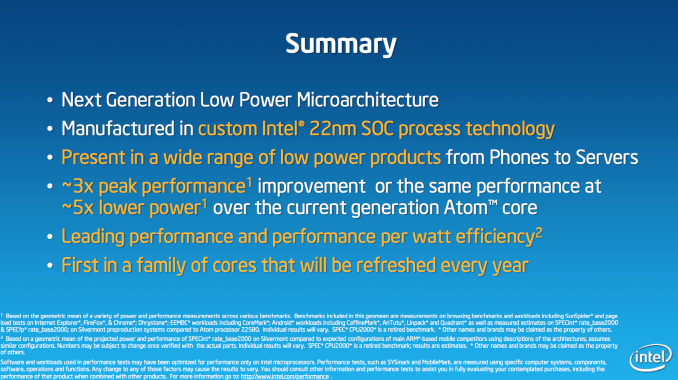Intel’s Silvermont Architecture Revealed: Getting Serious About Mobile
by Anand Lal Shimpi on May 6, 2013 1:00 PM EST- Posted in
- CPUs
- Intel
- Silvermont
- SoCs
Final Words
Silvermont really is Intel’s Conroe for the mobile market, but not in the sense that many have been expecting. Given that success in mobile is so closely tied to device wins, Silvermont alone isn’t enough. Unlike Conroe, a very competitive Silvermont won’t change the world overnight. What Silvermont does however is offer a great foundation for Intel going forward. Conroe lead to Penryn, Nehalem, Westmere, Sandy Bridge, Ivy Bridge and soon, Haswell. It was the platform that Intel could build on regularly by executing on tick-tock. Conroe paved the way for the insane advantage Intel has held onto for the past few years. Silvermont is like Conroe in that it provides that same foundation.
The mobile market is far more competitive than the PC industry was back when Conroe hit. There isn’t just one AMD but many competitors in the SoC space that are already very lean and fast moving. There’s also the fact that Intel doesn’t have tremendous marketshare in ultra mobile. Silvermont may feel a lot like Conroe, but the market it’s competing in is very different. That’s not to say that Intel can’t be successful here; it’s just not going to be easy.
Architecturally Silvermont is very conservative, and that’s not a bad thing. A side effect of not wanting to make Haswell irrelevant by a far lower cost part is the benefit of maintaining power efficiency. Intel joins the ranks of Apple and Qualcomm in intelligently scaling performance while respecting power consumption. Intel’s 22nm process should give Silvermont a lot of runway to use. If it can quickly follow up with 14nm, Silvermont’s power advantage could end up being akin to Conroe’s performance advantage in the mid-2000s.
Even so, Silvermont is long overdue. It’s the first mobile architecture where Intel really prioritized smartphones and tablets, and on paper, it looks very good. Now it’s up to Intel to turn a great architecture into great design wins. From what I’m hearing, we may actually see that happen.











174 Comments
View All Comments
GTRagnarok - Monday, May 6, 2013 - link
We'll miss you :'(Pheesh - Monday, May 6, 2013 - link
I don't think the Anandtech site will miss your views and contributions. I appreciated the article and explanations for what's to come. Not everyone cares only about 'specs'.Krysto - Monday, May 6, 2013 - link
That's what I hate most about Intel's press releases, too. They are typically HIGHLY misleading, in some way or another. Remember when they made people believe the 22nm IVB would be 37% faster AND 40% more efficient? - when it was actually one OR the other, but because of the way they phrased it in the PR...and the way tech sites cloned it in their articles, that's what most people got - that they get BOTH those benefits. In the end it was HALF of each.But the worst part about it is the "churnalism" that comes after it. Since most tech sites are either too ignorant or too lazy, they just rewrite what Intel said in the PR - no questions asked.
Please remember EXACTLY what Intel says Silvermont is capable of - and I PROMISE you when this chip gets reviewed, it won't even seem close, and if you remember everything, you'll be disappointed.
Khato - Monday, May 6, 2013 - link
Actually, I don't recall where Intel stating that IVB would be 37% faster AND 40% more efficient. I believe you're confusing technical information regarding the 22nm process capabilities with a product using that process... and incorrectly interpreting that process information to boot.Homeles - Monday, May 6, 2013 - link
The only thing that I can think of is the chart comparing voltage and gate delay on the first page of this article, which was circulating a lot before the launch of Ivy Bridge. There's nothing misleading about it though, unless you don't know how to read the chart.Homeles - Monday, May 6, 2013 - link
"That's what I hate most about Intel's press releases, too. They are typically HIGHLY misleading, in some way or another."Intel, AMD and Nvidia are all guilty of this, and you know it.
t.s. - Tuesday, May 7, 2013 - link
Exactly! Hate it. It looks like all of them have an inferiority complex. They have to boast. Not confident enough with their true offerings.AssBall - Monday, May 6, 2013 - link
You know I have been coming here for 15 years and thought exactly the same thing. This article is the worst. Terrible PowerPoint graphs and gibberish. No real information. Kind of a sadness.VivekGowri - Monday, May 6, 2013 - link
The "PowerPoint" graph actually came from Excel, but it came from an article from earlier this year: http://www.anandtech.com/show/6536/arm-vs-x86-the-... (see page 3). And I dare you to find a more thorough or more comprehensively researched and tested article on SoC power consumption literally anywhere else.AssBall - Tuesday, May 7, 2013 - link
I dared, "literally", but couldn't find much. Sue us for asking for better standards.